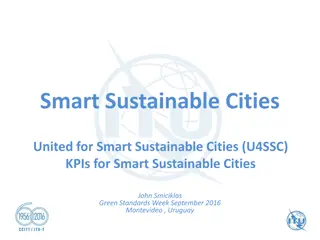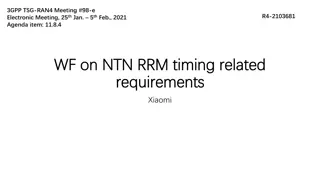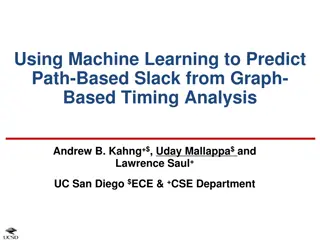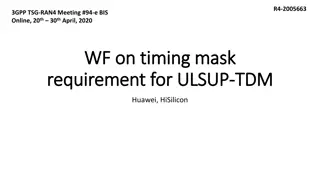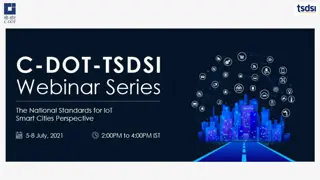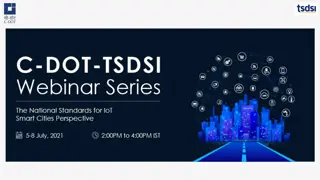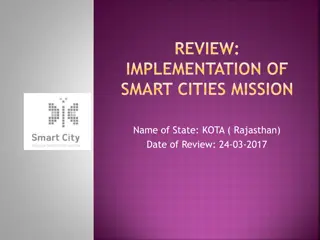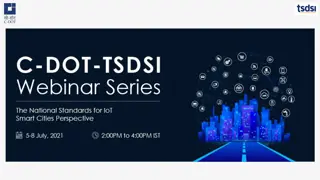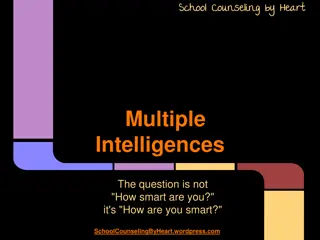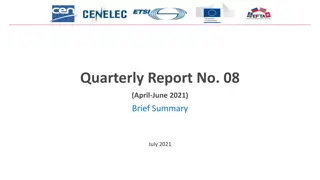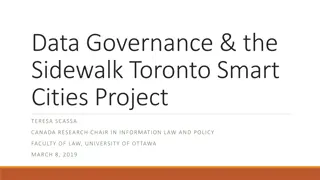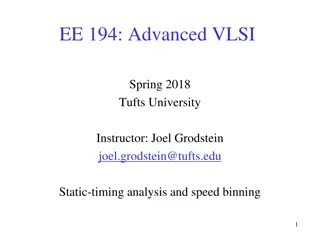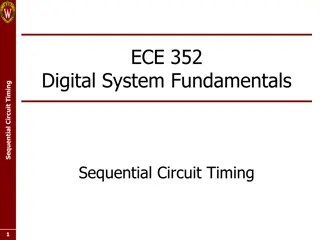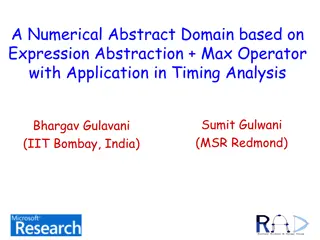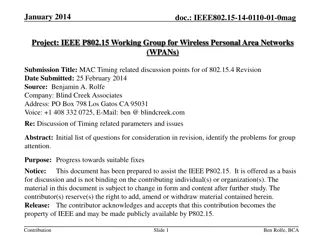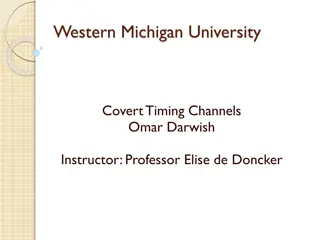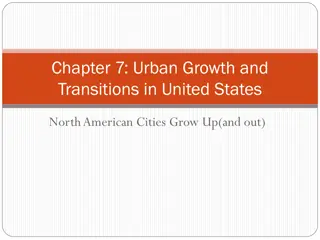Importance of Effective Timing and Synchronizations in Smart Cities
Effective timing and synchronizations play a crucial role in smart cities, facilitating communication between nodes in network systems. Time synchronization in wireless networks helps manage clock variations and energy consumption, aiding in tasks like location determination and proximity sensing. Despite challenges in achieving precise synchronization, protocols like RBS, TPSN, and FTSP offer solutions. A case study on detecting and locating Man-in-the-Middle attacks in fixed wireless networks showcases how analyzing RTTs and RSS can help identify attackers.
- Smart Cities
- Timing Synchronizations
- Wireless Networks
- Time Synchronization
- Man-in-the-Middle Attacks
Download Presentation

Please find below an Image/Link to download the presentation.
The content on the website is provided AS IS for your information and personal use only. It may not be sold, licensed, or shared on other websites without obtaining consent from the author. Download presentation by click this link. If you encounter any issues during the download, it is possible that the publisher has removed the file from their server.
E N D
Presentation Transcript
Importance of Effective Timing and Synchronizations in Smart Cities Ziqian (Cecilia) Dong, Ph.D. Assistant Professor Electrical and Computer Engineering New York Institute of Technology, New York, NY 10023
Layer view of time-aware systems Timing support for applications Time-aware network and communication systems Time and frequency transfer systems Oscillators and clocks Source: NIST Technical Note 1867 FEW Nexus in Sustainable Cities Workshop 10/8/2024 2
Time Synchronization Time synchronization is important in networks, wired or wireless. It is the fundamental requirement for communication between nodes on the network. Sent time Access time Propagation time Receive time FEW Nexus in Sustainable Cities Workshop 10/8/2024 3
Time synchronization in Wireless Networks Synchronization nodes can be utilized over a multi-hop wireless network. Hardware clocks have variations in oscillators, the clocks may drift and result in the durations of time intervals of events not observed the same among nodes. Applications: location and speed determination, relative proximity determination among nodes and energy saving. FEW Nexus in Sustainable Cities Workshop 10/8/2024 4
The challenge Precise clock synchronization is not always achieved between different hardware. Protocols from lenient to strict are available to meet different needs. o Reference Broadcast Synchronization (RBS) o Timing-sync Protocol for Sensor Networks (TPSN) o Flooding Time Synchronization Protocol (FTSP) FEW Nexus in Sustainable Cities Workshop 10/8/2024 5
A case study - Detecting and Locating Man-in-the- Middle Attacks in Fixed Wireless Networks Method to detect and locate a Man-in-the-Middle (MITM) attack in a fixed wireless network by analyzing round-trip time (RTTs) and measured received signal strength (RSS) from fixed access points. Evaluated three machine learning algorithms on the measured RSS dataset to estimate the location of a Man-in-the-Middle attacker. FEW Nexus in Sustainable Cities Workshop 10/8/2024 6
Man in the Middle Attack A MITM attack is considered an active eavesdropping attack, often carried out on the media access control (MAC) layer through address resolution protocol (ARP) cache poisoning The purpose of a MITM attack is to intercept a connection between two legitimate hosts in the network and pretending to be the intended sender or receiver of track between two legitimate nodes. in order to carry out different kinds of attacks such as capturing track between the two nodes FEW Nexus in Sustainable Cities Workshop 10/8/2024 7
MITM Attacker 10.42.0.34 00:0f:04:b2:68:ef A B (Server) IP: 10.42.0.1 MAC: B4:b6:76:19:2:21 (Client) IP: 10.42.0.14 MAC: 64:A3:CB:47:35:66 ARP Request: ...0.1? SRC: 68:ef, DST: 68:ef ARP Reply: 2:21? SRC: 2:21, DST: 68:ef ARP Request: 0.14? SRC: 68:ef, DST: ff:ff ARP Reply: 35:36? SRC: 35:36, DST: 68:ef ARP Reply: 0.14 is at 68:ef SRC: 68:ef, DST: 2:21 ARP Reply: 0.1 is at 68:ef SRC: 68:ef, DST: 35:66 ICMP Echo Request SRC IP: 0.1, DST IP: 0.14 SRC: 68:ef, DST: 35:66 ICMP Echo Request SRC IP: 0.14, DST IP: 0.1 SRC: 68:ef, DST: 2:21 ICMP Echo Response SRC IP: 0.1, DST IP: 0.14 SRC: 2:21, DST: 68:ef ICMP Echo Response SRC IP: 0.14, DST IP: 0.1 SRC: 35:66, DST: 68:ef FEW Nexus in Sustainable Cities Workshop 10/8/2024 8
MITM Attacker B A mBA r+TA TA mBA FEW Nexus in Sustainable Cities Workshop 10/8/2024 9
(5,4) (0,4) Server 4m 6.4 Meter Server to Client (0,2) (5,2) (0,0) (5,0) 5m Client FEW Nexus in Sustainable Cities Workshop 10/8/2024 10
(0,4) (5,4) Server MITM (0,2) 4m (5,2) Client (0,0) (5,0) 5m FEW Nexus in Sustainable Cities Workshop 10/8/2024 11
Experiment in EGGC 6th Floor FEW Nexus in Sustainable Cities Workshop 10/8/2024 12
Location estimation accuracy per point FEW Nexus in Sustainable Cities Workshop 10/8/2024 13
Location prediction accuracy FEW Nexus in Sustainable Cities Workshop 10/8/2024 14
Long Island FEW Nexus in Sustainable Cities Workshop 10/8/2024 15
Water quality data New York Suffolk County Chlorophyll A Station 15 Filterable 70 60 50 40 30 20 10 0 40400 40500 40600 40700 40800 40900 41000 41100 41200 41300 41400 41500 FEW Nexus in Sustainable Cities Workshop 10/8/2024 16
References [1] NIST Technical note 1867 [2] Ziqian Dong, Randolph Espejo#, Yu Wan# and Wenjie Zhuang#, Detecting and Locating Man-in-the-Middle Attacks in Fixed Wireless Networks, accepted to CIT. Journal of Computing and Information Technology, Special Issue on Network Security, August 2015. FEW Nexus in Sustainable Cities Workshop 10/8/2024 17
Thank you Questions FEW Nexus in Sustainable Cities Workshop 10/8/2024 18



